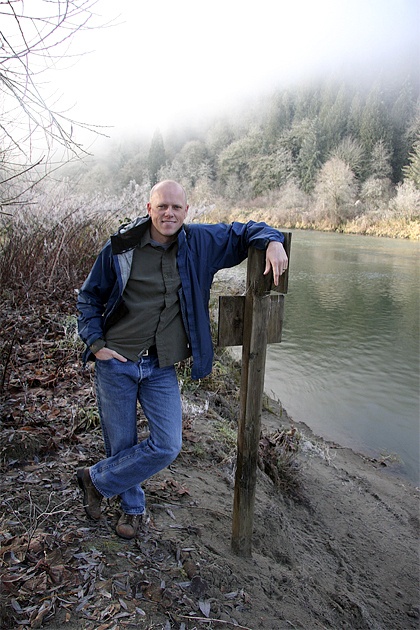Sipping coffee at the Carnation Starbucks one chilly fall morning, it took a single overheard word for Geary Eppley to get the kind of local celebrity treatment that few software programmers find.
The word: “Floodzilla.”
“Hey, Floodzilla! It’s got to be him,” a Starbucks patron said, shaking Eppley’s hand.
“I’m Geary, good to meet you,” Eppley replied.
Eppley is the creator of Floodzilla, the five-year-old Valley-centric Web site, where more than 500 subscribers watch rising river levels and get real-time flood updates. The site helps flood-prone residents stay one step ahead of rising waters. Everyone from Microsoft employees to King County staff follow his site, which has spawned a subculture of Web watchers who debate its predictions.
“In this area, everyone knows that it exists,” Eppley said.
Rise of Floodzilla
The Web site’s genesis came after Eppley moved to his Carnation home and lived through his first flood.
With high water closing off West Snoqualmie River Road early on, “we were trapped,” Eppley said. “During these big floods, we are completely inundated.” He measured five feet of water in his garage last January.
For Eppley, as for many Valley residents, being ready for a flood makes for a much smoother disaster experience.
“If we prepare, we can get cars out, we can canoe or wade out,” he said.
Already working in the software business, Eppley decided to write a personal program to monitor the National Oceanic and Atmospheric Administration (NOAA) flood alerts. His program ran on a home computer and sent him e-mails and text messages when it looked like a flood was coming. It worked well enough that, soon, his neighbors were on the e-mail list, too.
As Eppley developed new skills, he built a Web site to share his alerts. The site got a name and a cute graphic, and now the Valley-famed Floodzilla site was born. There are now more than 500 subscribers.
To sign up, visitors leave their e-mail address at the Web site. They can get a variety of updates, from emergency reminders to hourly messages. Eppley finds the frequent updates useful during a flood event, getting texts when he is on the go. Subscription is free.
Running the site costs a few hundred dollars a year. Most costs stem from renting a server on the other side of the country, out of any Snoqualmie flood’s reach.
Eppley reads and replies to all his fan mail.
“I have a whole e-mail folder full,” he said. “I often get emails from subscribers who love the site but would like to see additional functionality like customizable alert levels or support for other rivers. I will tackle these someday, but my real job keeps me pretty busy, so I can’t make any promises.”
By day, he works for PayScale.com in Seattle. Eppley also writes a food blog about eating lunch in Seattle’s International District.
“It’s fun being known for a site like Floodzilla,” Eppley said. “The floods can be stressful, even traumatic, and most of the people I interact with on a daily basis have no perspective on that part of my life. When I meet another person from the Valley, I immediately have some part of that shared experience in common.
“If flooding comes up and I let on that I’m the Floodzilla guy, I always get a warm thanks and story about how they found it and who they told about it,” he added.
When he first designed the site, Eppley found that if NOAA changed its Web page, his program didn’t work. To make sure information kept flowing even as Web sites change, Eppley worked with NOAA staff to help create a data feed. NOAA went on to make that pioneer effort a national standard.
Now, that feed covers rivers in several Western states. It opened Eppley’s eyes to possibly expanding Floodzilla’s role.
“It would be trivial for me to just make Floodzilla cover all those rivers,” he said. “I could (have) every river in the feed.”
Still, it’s hard for him to imagine encompassing such a big enterprise.
“I like doing this local thing. It’s much more personal,” Eppley said. When people have problems, he helps them. “It’s nice to be just a trusted community source.”
More water?
Eppley’s latest project is exploring flood trends in the Lower Valley.
This year, a group of Carnation and Fall City residents organized as Neighbors Against Flooding, voicing opposition to Puget Sound Energy’s plans to lower the coffer-dam at Snoqualmie Falls.
Some members of Neighbors Against Flooding have gone on record demanding a new study to determine whether Lower Valley flood levels have gotten worse as a result of the U.S. Army Corps of Engineers’ 205 Flood Reduction Project, which was completed in the early 2000s.
Eppley plans to compare flood gauge numbers from the upper and lower river valley before and after the project, subtracting the Tolt.
While he is not yet ready to go public with the numbers, “it looks like there may be a significant, measurable change since the 205 project,” Eppley told the Valley Record.
Eppley said he is tired of hearing contradictions in flood responses. Lower Valley residents have been told that predicted flood impacts from PSE’s latest project will be an inch or less. But when they ask for new studies, Eppley said they are told that river systems are too complex.
“It’s frustrating when you’re downstream,” Eppley said. “The people who are actually affected are so few, (compared) to the people living in the town of Snoqualmie. It’s sort of a battle.”
Flood information
- Visit Floodzilla.
- Visit the Valley Record’s Flood Page.



